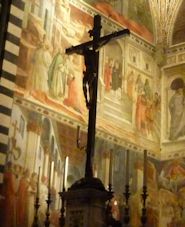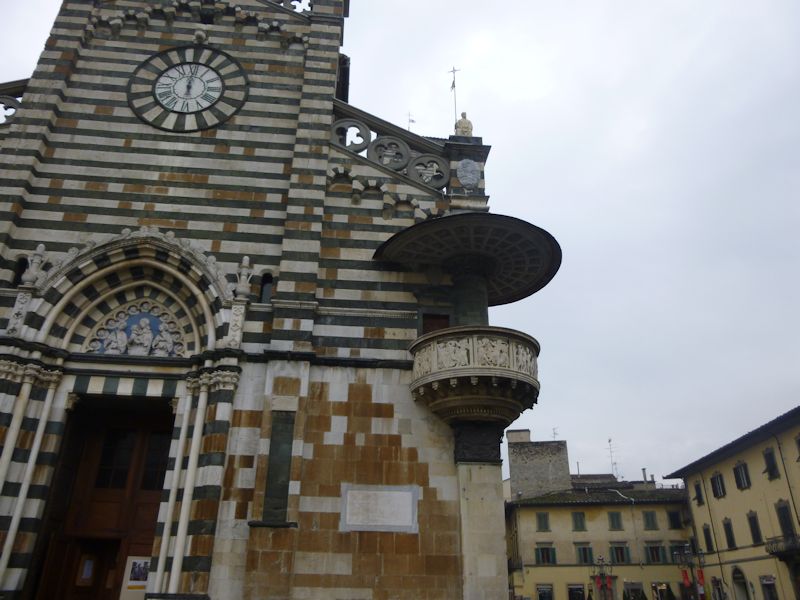|
 Dwight Peck's personal website Dwight Peck's personal website
Two weeks in Piemonte and Tuscany
in northwest Italy's worst weather in yonks
You may not find this terribly rewarding unless you're included here, so this is a good time for casual and random browsers to turn back before they get too caught up in the sweep and majesty of the proceedings and can't let go.
We wanted to visit Lucca and environs, so here we are in the environs . . .
A day's outing in Prato

Off to the Lucca train station on a rainy day, 22 November 2014

An hour's train ride to the northeast, towards Florence, brings us to downtown Prato, population ca. 190,000 but with a compact and convenient centro storico.

Along the Via Magnolfi towards the Duomo. The area around Prato gives evidence of settlements from Paleolithic times, and there seems to have been an Etruscan city here, which faded away in the 5th century BC. The Roman road the Via Cassia passed through between Florence and Pistoia, but there was no significant Roman presence otherwise.

Kristin and the very wet Piazza del Duomo

The Bishop's Palace (Palazzo Vescovile) and the Cattedrale di San Stefano, or Duomo di Prato, dedicated to Prato's patron saint, St Stephen, referred to in the New Testament (Acts) as the first Christian martyr.

A dignified 19th century statesman from Prato, Giuseppe Mazzoni, with a bird on his head

The piazza fountain and a booth by the charitable organization, the Emmaus Community of Prato
The Cattedrale di San Stefano, or Duomo di Prato

The present city of Prato was created in the 10th century, when two local villages were incorporated under the Alberti family and the Bisenzio River, which runs through the town, was tamed and put into service to supply a wool and textile industry that would be vital to the city's prosperity.

The original church, attested from 994 but presumably much earlier, was built on a pasture (or prato) near one of the original villages after the Virgin Mary appeared to somebody there (i.e., here). The present Romanesque building was developed in the 13th century, and a new façade was put on in the early 1400s; it gained cathedral status when a bishop was appointed in 1653. The beautiful glazed terra cotta Madonna with St Stephen and St Somebody was added by Andrea della Robbia in 1489.

A simple Romanesque Latin cross with a nave and two side aisles, from the early 1200s; the transept with its five chapels dates from 1317 to 1368. The green and white marble striping is characteristic of the Pisan-Romanesque style in the region.

In front of the presbytery, the pulpit on the left was created in 1473, and the bronze candelabrum on the right is from 1440. The bronze crucifix on the high altar is from the mid-17th century.

The high altar with the 1653 bronze crucifix

The pulpit, shaped like a chalice, with reliefs showing scenes from the lives of St Stephen and John the Baptist

The chapels flanking the high altar

The walls of the choir boast fresco cycles by Filippo Lippi from the mid-15th century showing the lives of St Stephen and John the Baptist, and they let you walk behind the high altar to see them better.

Poor St John losing his head

Across the way, the entrance to the Chapel of the Blessed Sacrament (early-mid 16th century)

Next to the Chapel of the Blessed Sacrament

The Vinaccesi Chapel, with a wood Christ from the 13th century and frescoes by a Pratesi artist from the late 19th century

The presbytery in front of the altar, with a 17th century balustrade

Fresco cycles in each of the five chapels

The Assunta Chapel, with frescoes from 1436 by Paolo Uccello

Kristin parsing the 15th century symbolism

Many of our favorite church frescoes involve beheadings.

The floor

Looking from the high altar to the exit, to which we will now proceed, but . . .

. . . as we leave, next to the front doors, this is the Chapel of the Holy Girdle, or goat's wool Holy Belt, built in the late 14th century to house the Sacro Cíngolo -- this venerated article was given by the Virgin Mary at the time of her Assumption into heaven to the apostle Doubting Thomas. Fast Forward: somewhat miraculously, a merchant from Prato obtained it in the dowry from his marriage to a woman in the Holy Land, and when he brought it back to Prato in 1141, angels instructed him to donate it to the church and city of Prato (or else), which of course he did. It's kept in this locked shrine, and keys kept by the canons of the Cathedral and the city's mayor are both required to fetch it out to be displayed to the mobs on special days. Frescoes by Agnolo Gaddi, from the 1390s, tell the story, the excellent Madonna+Child by Giovanni Pisano from ca.1300 on top of the altar can scarcely be seen in this photo, and we'll get a televised peek at the Holy Belt celebrations on the next page.

Kristin checking out the Emmaus

The famous external pulpit, sculpted in marble by Michelozzo Michelozzi and decorated by Donatello in 1438 expressly for the public display of the Sacred Belt of the Virgin

Angels are dancing happily

The dignified gentleman still has a bird on his head.

The Duomo with its exterior pulpit and belltower from the early 13th century, with the top story stuck onto it in 1356.

Zoom

In place of a rose window, a cathedral clock, originally a mid-15th century clock with an automated child who struck the hours; the present clockworks date from 1795, though the clock face is the original.

Triple windows on the top section, added in 1356.

The Piazza del Duomo. Prato was able to become a free commune after the 'Gran Contessa', Matilda of Canossa, forced the Albertis out in 1107, and thereafter thrived as a satellite of Florence with a vigorous textile industry and the pilgrimage attraction of the Holy Belt.

In the 12th through 15th centuries, Prato shared the turbulent politics of the Guelph (papal) and Ghibelline (imperial) factional conflicts amongst northern Italian cities, but in general, then and long thereafter, shared the fortunes of its larger neighbor Florence; during the tortuous War of the Holy League, the city was sacked in 1512, and its population massacred, by a Spanish army as part of the Pope’s efforts to re-install Medici rule in Florence.

The Via G. Mazzoni (that's the guy with the bird on his head)

From the 19th century onward, Prato has been a leading industrial centre, and is presently the third or fourth largest city in central Italy, after Rome, Florence, and perhaps Livorno. It also competes with Milan for the largest Chinese immigrant population in Italy, largely due to an influx in the 1990s to work in the garment industry.

The Piazza Pretorio, presently the museum and pinacoteca. That's next.
       
     

 Feedback
and suggestions are welcome if positive, resented if negative, Feedback
and suggestions are welcome if positive, resented if negative,  .
All rights reserved, all wrongs avenged. Posted 12 January 2015. .
All rights reserved, all wrongs avenged. Posted 12 January 2015.
|
 Dwight Peck's personal website
Dwight Peck's personal website




















































